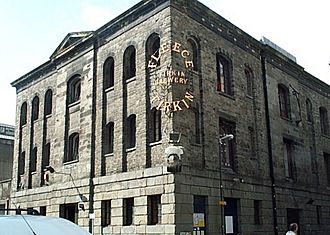Wool Hall, Bristol facts for kids
Quick facts for kids The Wool Hall |
|
|---|---|
 |
|
| General information | |
| Architectural style | Neoclassical |
| Town or city | Bristol |
| Country | England |
| Coordinates | 51°27′08″N 2°35′22″W / 51.4522°N 2.5894°W |
| Completed | 1830 |
| Cost | £4400 |
| Design and construction | |
| Architect | Richard Shackleton Pope |
The Wool Hall is a special old building in Bristol, England. It is located on St Thomas Street in the Redcliffe area. This building was created a long time ago, in 1830, to help with Bristol's important wool trade.
Bristol's Wool Story
For hundreds of years, the wool trade was very important in Bristol. People used wool to make clothes and other items. However, some parts of preparing wool, like softening it, could create a strong smell. Because of this, the wool businesses were moved away from the city center to areas like Redcliffe.
Why The Wool Hall Was Built
By the early 1800s, the main bridge in Bristol, Bristol Bridge, became very crowded. Farmers bringing their sheep and wool across the bridge caused big traffic jams. To fix this problem, the city decided to build a new place just for the wool market. This new building, The Wool Hall, was finished in 1830.
The building was designed by an architect named Richard Shackleton Pope. It had a grand, balanced look, typical of the classical style. Inside, the ground floor was used for weighing wool. The floors above were used to store the wool. Building The Wool Hall cost about £4,400, which was a lot of money back then!
From Wool to Music
Even though it was built to help the wool trade, The Wool Hall wasn't very successful at first. It was too far from the main farmer's markets at Temple Meads. So, by 1834, the wool trade moved to another building called the Corn Exchange.
Luckily, The Wool Hall survived the bombing of Bristol during World War II. Many other old buildings nearby were destroyed, but The Wool Hall remained standing.
In 1980, the building got a new life. It was changed to include new doors. The ground floor became a pub and music venue called the Fleece and Firkin. The upper floors were used as offices. The Fleece became a famous place for live music. Many well-known bands played there, including Oasis, Pulp, Emeli Sande, Radiohead, and Amy Winehouse.
A Protected Building
Because of its history and special design, The Wool Hall was given "grade II listed building" status in 1975 by English Heritage. This means it's an important historical building that needs to be protected and preserved for the future.

